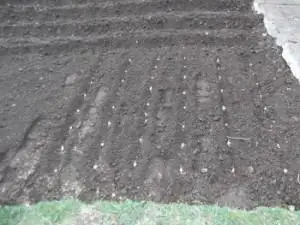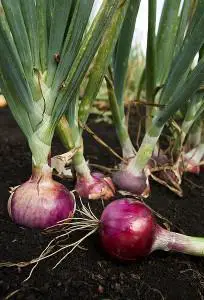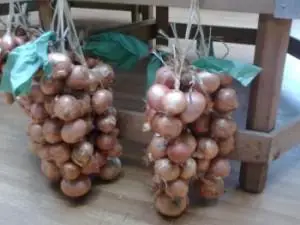Introducing The Onion
To begin with, when asking how to grow onions, we must decide on whether to grow the onions from seed or from onion sets. The fact is that it is generally thought much easier to grow onions from sets rather than from the seeds themselves. It is also more likely that you will have a successful onion crop if you grow from the onion sets, unless you are a more experienced gardener and are well used to the intricacies of germinating and growing vegetables from seed.
Growing Onions From Sets
As mentioned, it is generally thought of as a more guaranteed way to produce a good crop of onions, if you grow from onion sets. There are a few basic things to go think about, before you simply plant your onion sets in the ground however. A few general rules of thumb to ensure your efforts are productive and the expenditure worthwhile, from both a financial and practical viewpoint.
Growing Onions in Straw Bales needs a slightly different approach. You can check out This Post to get the general layout for straw-bale-gardening techniques for growing onions.
Soil Condition:
It is not considered wise to grow onions in the same bed for more than 3 years running, unless the previous crop has been disease free, and the soil is well fertilized and able to cope with the demands of the growing onions. generally as with most vegetable crops, it is better to rotate your plants around the growing area if this is possible, in order to ‘spread the load’ and give each plant the best possible chance of solid growth.
This possibility of disease laying in the soil can be overcome at the end of the growing season, by treating the soil with a dilution of jeys fluid. This will ensure a disease free soil for the next seasons growing.
Onions should be planted as early as possible (around late Feb) to give as long a growing period as possible, in a soil ph of between 6 and 7.5 and should be planted in ground, that is well raked out to produce a fine tilth for planting the onions sets into. Preferably you will have turned over the ground and added some well rotted manure the previous Autumn, this will ensure a good strong growth in the spring – if not; then remember it for next year 🙂
After pressing down the area a little (onions prefer a firm bed), plant the onion sets about 4 inches apart, in rows set about 1 foot apart. This gives roof for the hoe when it comes to weeding between the rows. Plant the onions in a small hole made with the trowel, and cover them up to the neck in soil. Planting them like this will help prevent them climbing out of the ground as the roots start to take hold; with that in mind however, you will most likely have to re-set then a few weeks after planting to be sure this does not happen. A small sprinkling of grow-more will help at this stage to give the onion sets a quick boost.
about 4 inches apart, in rows set about 1 foot apart. This gives roof for the hoe when it comes to weeding between the rows. Plant the onions in a small hole made with the trowel, and cover them up to the neck in soil. Planting them like this will help prevent them climbing out of the ground as the roots start to take hold; with that in mind however, you will most likely have to re-set then a few weeks after planting to be sure this does not happen. A small sprinkling of grow-more will help at this stage to give the onion sets a quick boost.
Protecting from Birds
Onions are not susceptible to garden pests like pigeons, in the same way that say for instance lettuce or cabbage is. However they are prone to inquisitive birds like Blackbirds and Crows, pigeons etc, that will pick them out of the ground and leave them lying on the surface. This is only usually a problem in the early stages of growth, and when the onion sets are properly rooted it is not so much of a problem. Nevertheless, if you are badly bothered with this happening to your onion sets then it is as well to put a fine mesh over them to protect the sets in the early stages of growth.
Harvesting the onions
Onions are ready to pick, usually around August, when the foliage becomes yellow and withers. Pick a dry day if possible and lift gently from the ground, leaving the onions to dry where they are for a little while. They are then ready to store in a cool dry place, where they will last through-out the winter – provided you keep them free from frost damage.
The dried withered Shaw’s can be pleated together, enabling them to be hung up in bunches from the ceiling of your garden shed for instance. After about two weeks of drying out, the onions are ready to eat and should provide you with a fresh supply for the next few months – if you have grown enough!
Quick tip: Eat the ones with the thick necks first, as they do not last as well.



